(Franco-Pedroso, J., 2019) Generating Virtual Scenarios of Multivariate Financial Data for Quantitative Trading Applications

Franco-Pedroso, J., Gonzalez-Rodriguez, J., Cubero, J., Planas, M., Cobo, R., & Pablos, F. (2019). Generating Virtual Scenarios of Multivariate Financial Data for Quantitative Trading Applications. The Journal of Financial Data Science, 1(2), 55–77.
1 Introduction
2 Assessment of simulated financial time series
3 Evaluation of stochastic models as simulation methods
4 Generation of virtual scenarios for multivariate data
5 Generation of new artificial assets
6 Analysis of long-term high-dimensional virtual scenarios
7 Conclusion and future work
- To develop a technique that
- allows to simulate virtual scenario of given financial market
- involving hundres/thousands of assets
- for time period of arbitrary lengthwhere : virtual scenario, : given financial market, : the set of assets and is a proper function.
| Section | Question | |
|---|---|---|
| 2 | How to evaluate simulated scenarios? | Just sanity check |
| 3 | Limitation of existing models | |
| 4 | Proposed model to generate virtual scenarios | |
| 5 | Proposed method to generate artificial assets | |
| 6 | Sec4+Sec5 and Evalutaion |
How to evaluate simulated scenarios?
- Assessment of simulated financial time series
- Data desciption
- Stock prices/returns
- Period : 2000/01/01 ~ 2016/04/29
- 330 stocks in S&P500 index
- Market index
- Equally weighted
- Empirical properties of financial time series
- Distributional properties (of asset returns)
- shape-piked, fat-tailed : larger kurtosis (> 3)
- skewness : individual stock/marker index
- rolling metric : time-varying dynamics
- Dependency properties
- Volatility clustering : ACF(Autocorrelation function) of absolute/squared returns
- Pathwise properties
- The irregularity of the trajectory
- meaused by the number of (linear) trends (segments) over a given time period
- Trend ratio
- = the return / (the period of the contained trend / the noise level)
- = (the return * the noise level) / the period of the contained trend
- Cross-asset relationships
- Correlation coefficient matrix
- What about dynamic behavior? (time-varying)
- Number of trends (linear segments) in Market index!
- Directional similarity
- =the percentage of assets whose prices move in the same direction with market index (within a given direction)
- moving average with window size = 50, step size = 1
- Financial time series : returns? price?
- Usually, modeling return!
- Because, price is nonnegative
- (In 2.1, p.4) How to account for the correlation between assets by market index(=average of assets)?
- Can kurtosis grasp shape-pike property of asset dist'n?
- Definition of asset return?
- Large autocorrelation in large lag value
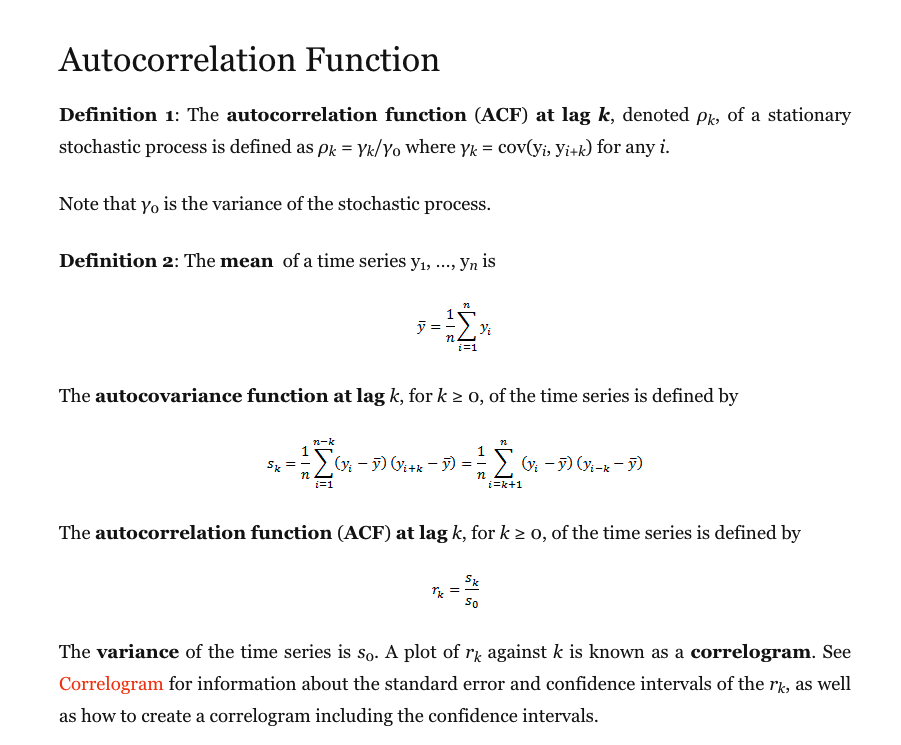
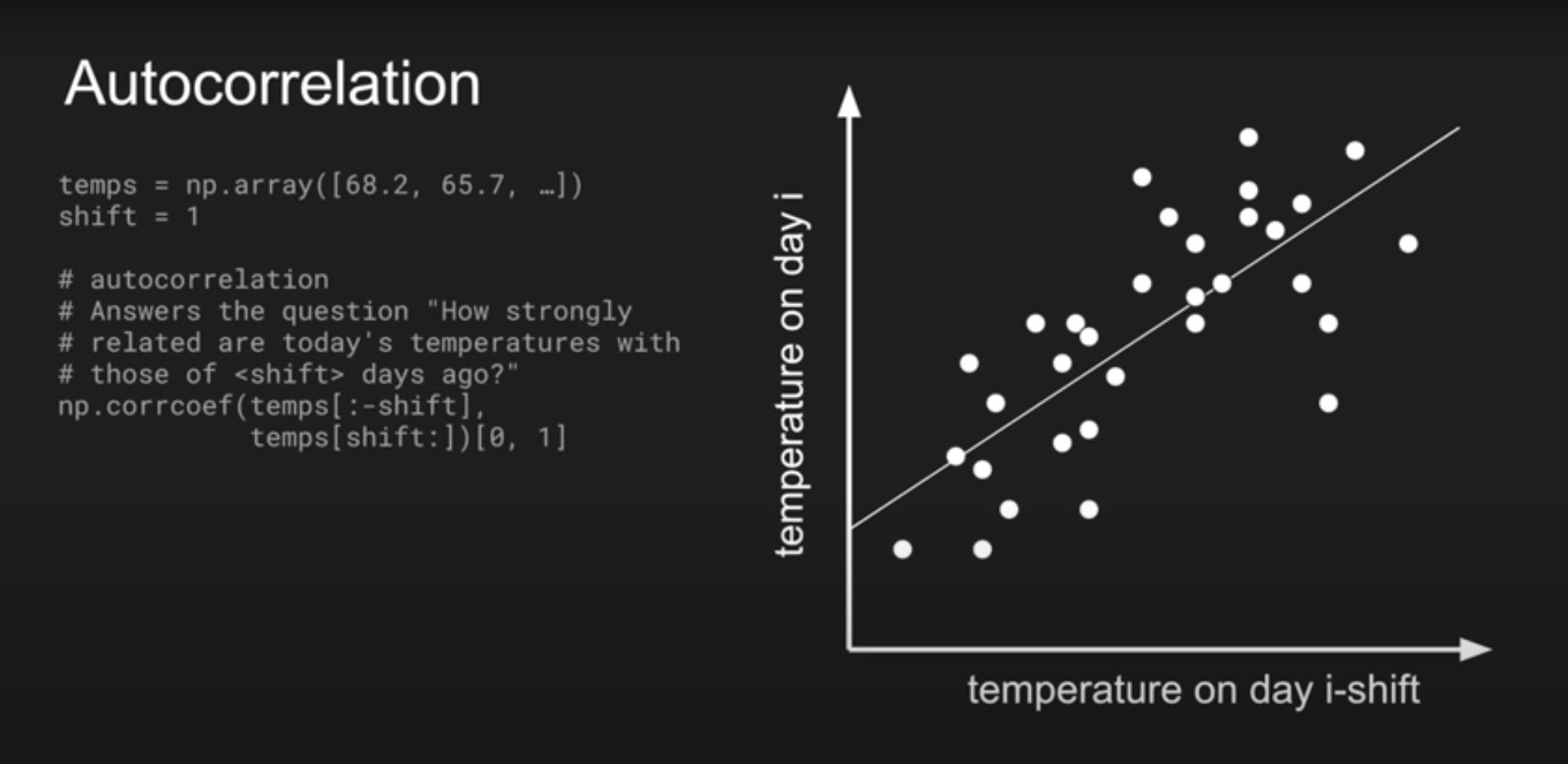
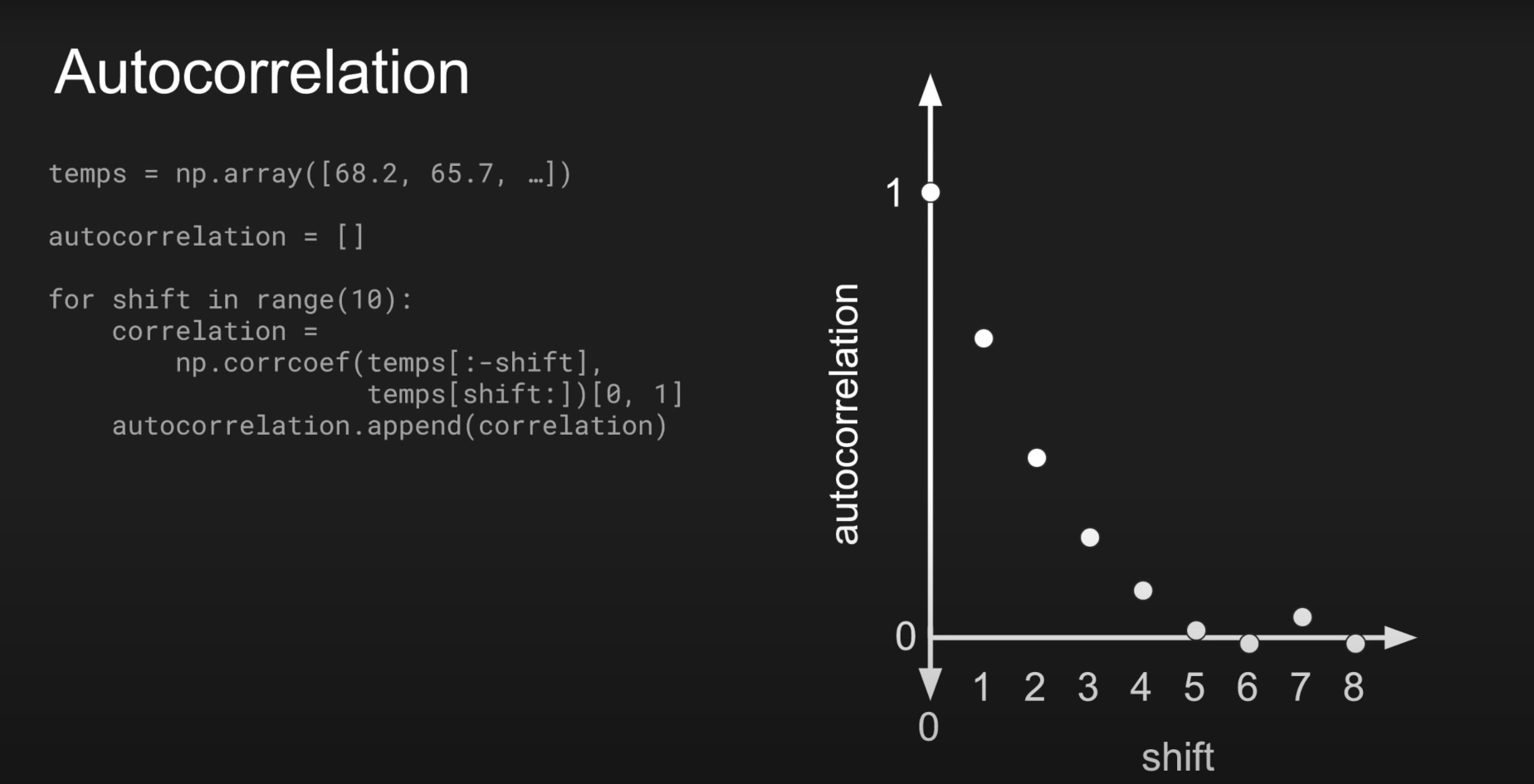
- (In 2.2.3, p.8) What is "the noise level?"
Existing models to generate scenario : Univariate
- Stochastic models
- GBM(the Geometric Brownian Motion)
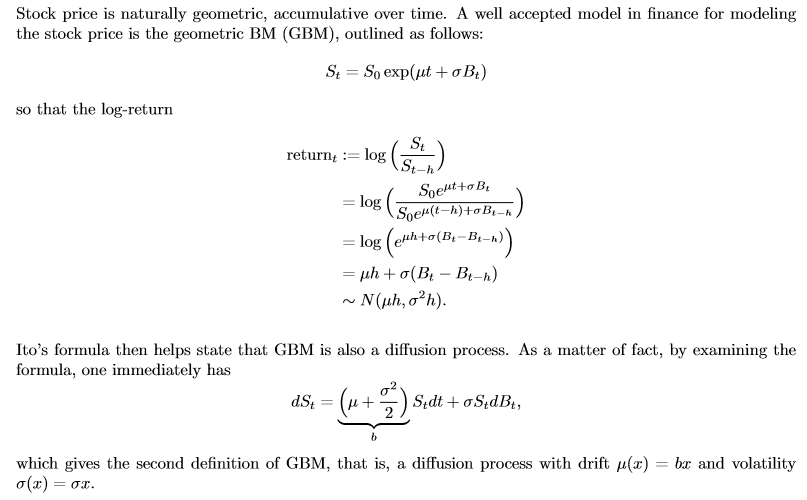
- fails to reproduce the excess of kurtosis
- fails to reproduce the volatility clustering feature
- GBM(the Geometric Brownian Motion)
- Volatility models : ARCH, SV
- Modeling volatility as a time-varying process
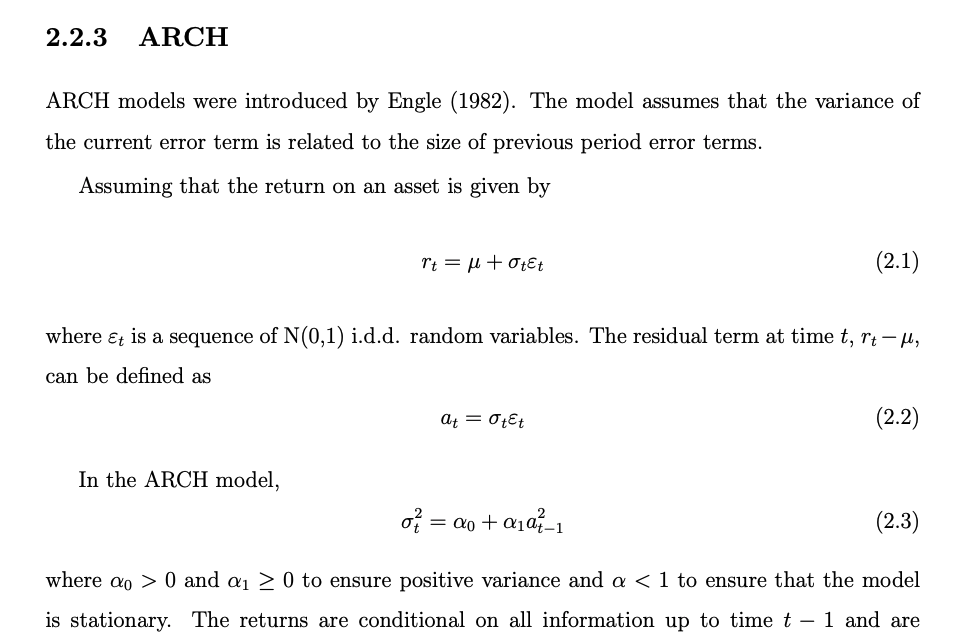
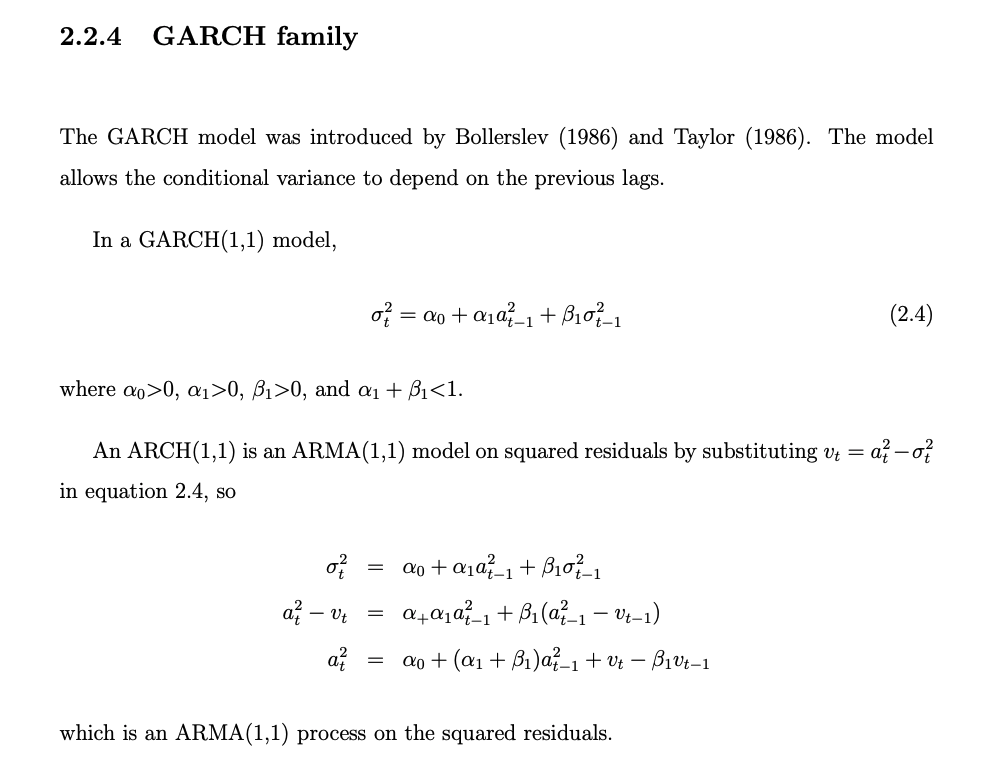
- GARCH : reveals the volatility clustering & the excess kurtosis,
- But when analyzing rolling of them , GARCH model vary at a slower rate that in real stocks -> a different dist'n is needed
- GARCH + Student's t innovation
- the excess of kurtosis can be better reproduced & the variance of rolling kurtosis value is still low
- while rolling skewness values vary in a more similar range than that of the real stock
- Modeling volatility as a time-varying process
Generation of virtual scenarios for multivariate data
- Section4
Stage1) The analysis stage
- [Segmentation] Detecting of market trends
- Input : market index (eqally weighted)
- Output : change point, signs
- How:
- package
piecewise_regression - package
pwlf
- package
- cf. There is any seg method with alternating sign constraint?
- [Estimation] Analyzing the multivariate data within each trends to capture both dynamic and statistical properties
- Within segment , (
- Let all obeserved return values :
- The corresponding set in sliding window :
- What is the step size of sliding window? 1?
- Totally, there are normal distributions
- Input : data points {r}_{w(s)}^{L}, sliding window size
- Output :
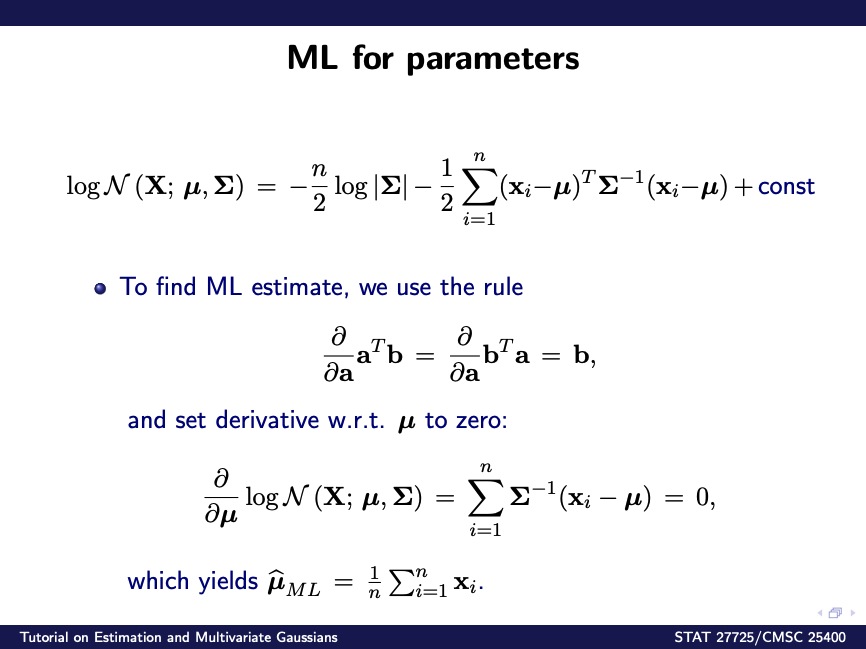
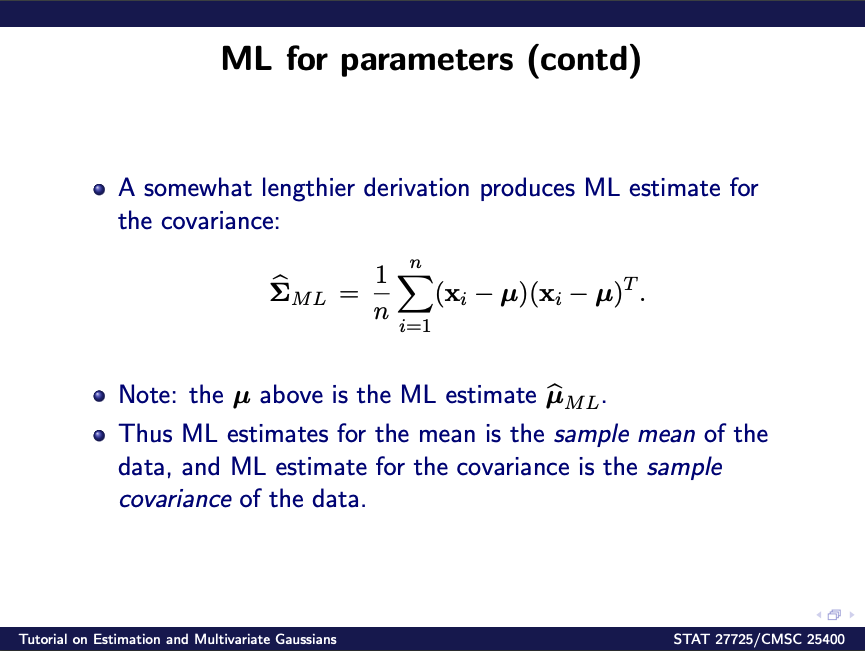
- Within segment , (
- functions
def mul_normal_est(x, L):
w = len(x) - L + 1
for i in range(1, w):
# estimate the multivariate normal distribution
return mu_list, Sigma_list- Body
market_index = # market index data set (equally weighted)
detected_trends = trend_detection(market_index)
Segments = detected_trends['change_points']
for seg in Segments:
for win in Windows:
mu_hat = # estimation for mu in current sliding windows
Sigma_hat = # estimation for Sigma in current sliding windows
mu_trend = mu_trend.append(mu_hat)
Sigma_trend = Sigma_trend.append(Sigma_hat)
mu_total = mu_total.append(mu_trend)
Sigma_total = Sigma_total.append(Sigma_trend)Stage2) The synthesis stage
- [Hypothesizing] A stochastic sequence of trend is hypothesized
- What hypothesized means in accurate?
- cf. with constraint alternating signs!
- [Random generation] For each trend, learned parameters are recovered and multivariate random asset returns are generated for that trend
- Within a given trend, the sequence of parameters is recovered(estimated)
- random sampes are drawn(generated) from each multivariate Gaussian distribution totally, within a trend, generated points!
- The distribution of simulated asset returns is given by
- [Concatenation] Once the return values have been simulated for each trend to be generated, those returns paths are concatenated
Generation of new artificial assets
- Section5
PCA recovery-projection process
-
Applying PCA to asset returns,
where : a given data set with asset returns from trading days, : a transfomation matrix of eigenvectors, and : the projected asset returns (or components in PCA)
- In matrix form, can be represented as below:where : component, : eignevector and : (observed) asset return at time .
- In matrix form, can be represented as below:
-
In order to generate new artificial assets,
where : the projected asset returns (or components in PCA) (computed above), : an artificial transformation matrix (generated below), and : artificially generated assets
- In matrix form, can be represented as below:where : additional eigenvectors , : component, and : generated asset returns at time .
- In matrix form, can be represented as below:
-
How to generate additional eigenvecotors?
where and .
Correction of expression
| Paper | Python |
|---|---|
| For a given dataset of asset returns from trading days (), a PCA transformation matrix can be obtained and these assets projected through , being the projected asset returns or components. - : a given dataset with asset returns and trading days () - : a PCA transformation matrix () - : the projected asset returns or components () If no dimension reduction is applied, is a transformation matrix of eigenvectors that maps the original vectors of asset returns into their components . -, where is a matrix whose column is eigenvector for | R = df_wide.copy() pca = PCA(n_components = n_comp) pca_fit_transform = pca.fit_transform(R.T) Y = pca.inverse_transform(pca_fit_transform) |
| The procedure used to generate those additional eigenvectors is to draw them from a multivariate normal distribution with parameters and . | COMPONENTS = pca.components_mu_hat_for_EV = list(map(lambda x : np.mean(x), COMPONENTS))Sigma_hat_for_EV = np.cov(COMPONENTS)W_prime = np.random.multivariate_normal(mu_hat_for_EV, Sigma_hat_for_EV, S_new) |
| The components are projected back to the original space by applying the inverse transformation. - : an artificial - : the components - : a new artificially generated set of assets | generated = np.matmul(pca_inverse_transform, W_prime.T) |
How to combine these techniques?
-
The final goal
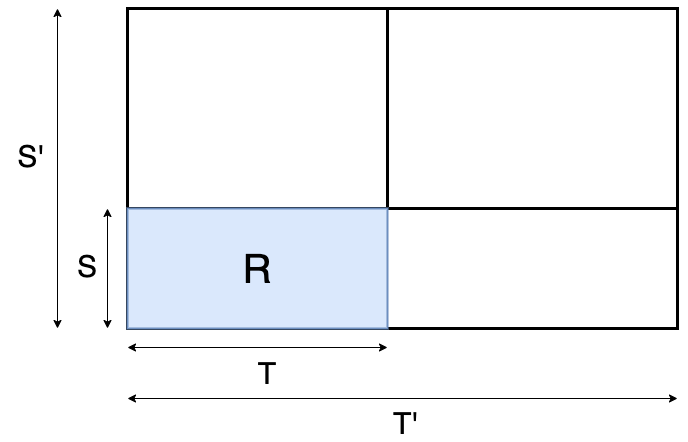
-
Candidate scenarios
- Candidate2 seems more reasonable!
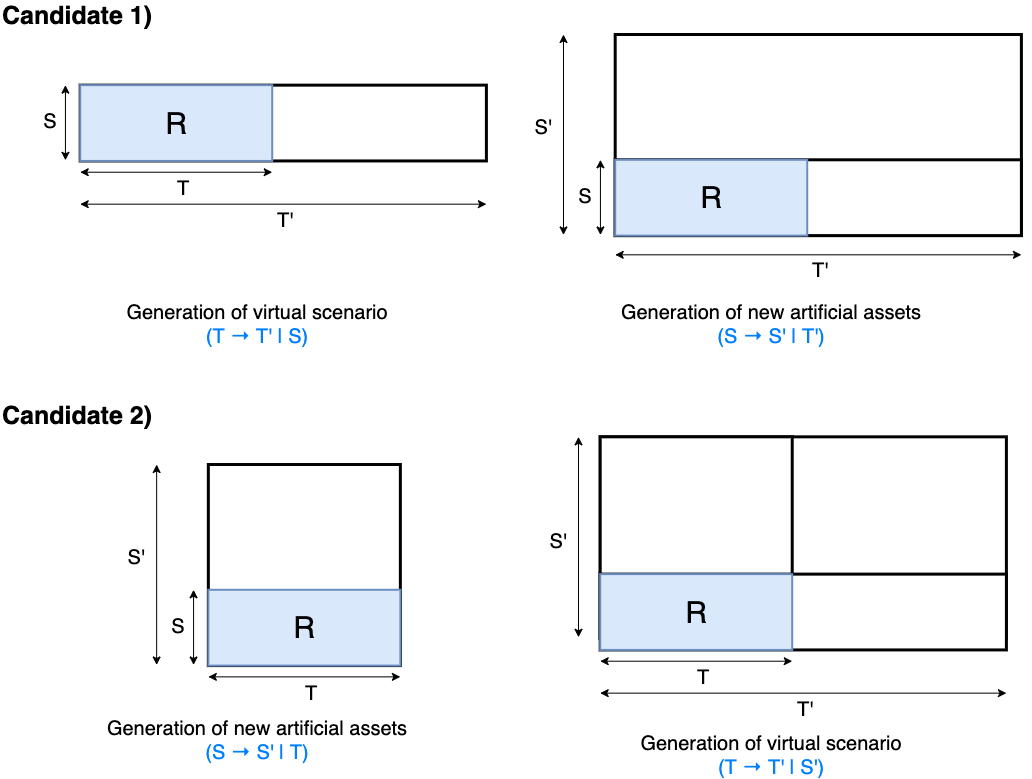
- Candidate2 seems more reasonable!
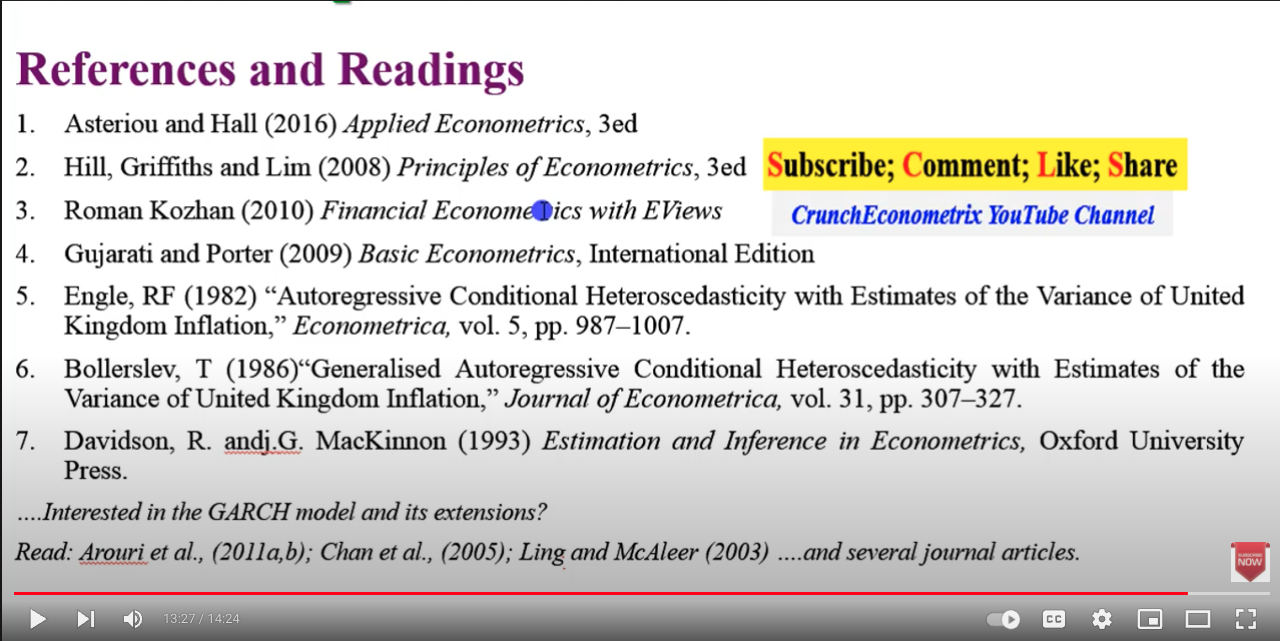
Python source code
from datetime import datetime
import os
import traceback
N_rep = 3 # 1000 # number of repetitions
trial_id = 0
n_comp = 330 # number of PCs
S_new = 3 # 500 # size of artificial assets
N = 100 # 5000 # virtual scenario size (time length)
logger = make_logger()
for rep_idx in range(N_rep):
random.seed(rep_idx + 1)
logger.info("repeat = {} with random.seed({})".format(rep_idx + 1, rep_idx + 1))
start_time = datetime.now()
### Generating artificial assets
R = df_wide.copy()
try:
pca = PCA(n_components = n_comp)
pca_fit_transform = pca.fit_transform(R.T)
pca_inverse_transform = pca.inverse_transform(pca_fit_transform)
COMPONENTS = pca.components_
COMPONENTS.shape
mu_hat_for_EV = list(map(lambda x : np.mean(x), COMPONENTS))
Sigma_hat_for_EV = np.cov(COMPONENTS)
except Exception as e:
trace_back = traceback.format_exc()
message = str(e)+ "\n" + str(trace_back)
logger.error('[FAIL] %s', message)
W_prime = np.random.multivariate_normal(mu_hat_for_EV, Sigma_hat_for_EV, S_new)
generated = np.matmul(pca_inverse_transform, W_prime.T)
R_prime = pd.DataFrame(generated.T.copy())
P_prime_T = return_to_price(pd.DataFrame(generated))
### Estimation for multivariate normal
mu_total = []
Sigma_total = []
window_sizes = []
for seg in range(len(breakpoints) - 1): # [0]:
R_prime_seg = R_prime.iloc[:, breakpoints[seg]:(breakpoints[seg+1] + 1)]
seg_size = R_prime_seg.shape[1]
W = seg_size - L
window_sizes.append(W)
# print('>>> Seg {} : {} data points, {} windows'.format(seg + 1, seg_size, W))
mu_trend = []
Sigma_trend = []
for w in range(W):
R_prime_window = R_prime_seg.iloc[:, w:(w+L)]
mu_hat = R_prime_window.mean(axis=1)
Sigma_hat = np.cov(R_prime_window)
mu_trend.append(mu_hat)
Sigma_trend.append(Sigma_hat)
mu_total.append(mu_trend)
Sigma_total.append(Sigma_trend)
### Random generation & Concatenation
n_gen = int(np.ceil(N / sum(window_sizes)))
n_seg = np.asarray(mu_total).shape[0]
virtual_scenario = []
for seg in range(n_seg):
mu_trend = mu_total[seg]
Sigma_trend = Sigma_total[seg]
# print(">> Seg {}".format(seg + 1))
window_size = np.asarray(mu_trend).shape[0]
# print(">> window_size : {}".format(window_size))
for w in range(window_size):
mu_hat = mu_trend[w]
Sigma_hat = Sigma_trend[w]
generated_returns = np.random.multivariate_normal(mu_hat, Sigma_hat, n_gen)
virtual_scenario.extend(generated_returns.tolist())
vs_return0 = pd.DataFrame(virtual_scenario)
selected_idx = np.random.permutation(vs_return0.shape[0])[:N]
selected_idx.sort()
vs_return = vs_return0.iloc[selected_idx, :].reset_index(drop=True) # copy().take(selected_idx.sort()).reset_index(drop=True)
vs_price = return_to_price(vs_return)
virtual_market_index = vs_price.mean(axis=1)
# print('a:{0:05d}'.format(a))
save_dir = './results/repeats/rep_{0:04d}'.format(rep_idx + 1)
if not os.path.exists(save_dir):
os.makedirs(save_dir)
vs_return.to_csv(save_dir + '/vs_return.csv'.format(rep_idx + 1))
vs_price.to_csv(save_dir + '/vs_price.csv'.format(rep_idx + 1))
virtual_market_index.to_csv(save_dir + '/vs_market_index.csv'.format(rep_idx + 1))
end_time = datetime.now()
time_diff = end_time - start_time
tsecs = time_diff.total_seconds()
print(">> Repetition {} (spent {} mins)".format(rep_idx + 1, round(tsecs / 60, 2)))
del vs_return, vs_price, virtual_market_index